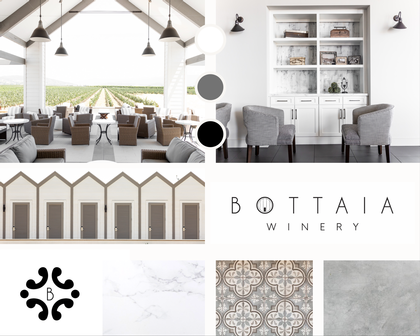Building BOTTAIA Winery
HOW TO BUILD A WINERY
FOR FUN + PROFIT
Ever since we built Bottaia Winery, many Wine Club members have asked me to tell the story of the winery. As I finished writing it, I realized that in fact, I had written an abridged manual with rules and lessons on how to build a winery.
In other words, this blog can be seen two ways: For the curious, plenty of background on our original thinking about Bottaia and how we made this concept a reality. And second, for those looking to enter the incredibly risky wine business, a manual “…for Dummies,” with some hard-learned lessons. Enjoy the reading and feel free to contact us if you have questions or comments.
BACKGROUND:
When Ponte Winery opened back in 2004, we did not expect what started as a mid-sized, yet up-to-date Tasting Room and casual Café, would become what it is today. In a few years, Ponte turned into a full-scale hospitality operation complete with weddings and events, a 90-room luxury inn, expansive tasting rooms, and upscale outdoor dining. Unfortunately, with all of these amazing and unique features came overwhelming crowds, long waits, a large staff, and all the troubles of a large, popular venue.
In 2014, a business partner and I had a meeting that would mark the starting point of our new winery: BOTTAIA. During this meeting, we decided to build a winery to improve upon the Ponte Winery experience, which was affected by the large crowds, long waits, and the occasional guests who were not interested in wine, but just a party. Buses and limos (and later Uber) brought folks already well past “sideways” status, forcing us to hire security and tighten the reigns on guest behavior. You get the picture.
We decided to design a new winery that would eliminate (instead of controlling) the crowding and the party behavior.
THE DESIGN:
From the start, we wanted to draw inspiration from the elegance of northern Italy. From the wine varietals that were chosen, the unique experiences developed, and intentional branding, the inspiration for BOTTAIA would flow all the way through every aspect of the winery. The lengthy inspiration process required trips to Italy to study the local wineries, restaurants, hotels, coffee shops, museums, and more.
During subsequent creative meetings, we decided the exception to the northern Italian thematic would be the facades. For these, we decided to rely on classic American architecture. The "modern barn” style has always been extremely popular in high-end North American wineries, given the simple gabled forms and the unmistakable connection to farming. Credit for this inspiration goes to the great wine country architect, Howard Backen, fully deserving of his fame as the ultimate practitioner of the form. Unfortunately, working out of Napa, he was too busy (and, frankly, too expensive) to design our project.
For the buildings’ layout, we instead found inspiration in the Venetian plains, also known as the Veneto, where the Grand Master of Architecture Andrea Palladio designed and built many rural villas in the 16th century when Venice was at the peak of its powers. Palladio built these amazing villas on a 6-foot pedestal so they would rise above the surrounding plains and improve the views from the noble floors. He placed subsidiary buildings on the flanks, production on one side, and storage or stables on the opposite side. Remember, these were working farms surrounded by hundreds of acres of farmland. Their owners would spend the summer away from their Grand Canal palaces with their families and employees while running large business empires spanning the Mediterranean. For more information on Palladio: https://en.wikipedia.org/wiki/Andrea_Palladio
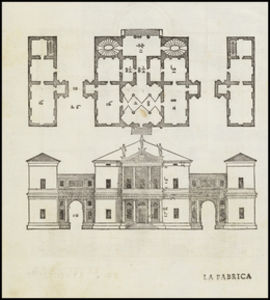
WINES + VINES:
Fortunately, I had been experimenting for years with several Italian varieties, so it was easy to decide we would exclusively use those for the new winery. Montepulciano and Vermentino were expected to provide strength and power, while Sangiovese and Pecorino elegance and delicate flavors. Other varieties like Nero d’Avola and Sagrantino would be added to the roster as we grew.
The vineyard surrounding the winery was mature with 15 varietals of Italian grapes and the elevated winery faced the gently rolling rows of vines.
For the wine style, we wanted to respect the old-world traditions of winemaking, while embracing modern winemaking technology. Bottaia's fermenters are made of concrete and oak for red wines, and we use steel tanks for blending and making white wine and rosés. We selected the winemaking techniques to emulate those used in various regions of Italy for each specific variety. Each variety gets a different yeast, a different fermentation protocol, and a different aging and maturation treatment.
For years we had been making our wine blends in the small lab at Ponte Winery. Here, dozens of wine lots are carefully measured, combined, and tasted by our winemaking team, our sales team, marketing team, and our culinary folks. It is a grueling process. Due to lack of space, we had to break it into multiple sessions, thus limiting the most important part of the exercise: hearing each other's opinions and exchanging ideas.
At Bottaia we designed and built a professional-grade blending lab. Northern exposure provides natural light for the room. Large white quartz counters that can fit hundreds of samples (for up to 12 tasters) surround a long stainless-steel spittoon. Light-colored walls, refrigeration, space for lab coats, computer connectivity, etc., everything you’d want to “blend like a boss” is there. It is a dream come true for our team. It felt like moving directly from your mom’s basement to a penthouse loft in Manhattan after selling a bunch of Apple stock you inherited.
The result of these efforts? Wines with depth, elegance, and complexity!
NAME + BRAND:
Within Italian wineries, the “Bottaia" is the aging building or cave housing the large casks used to slowly age important red wines. Bottaia, however, was not our first choice for the name of the winery.
The story started when I made the branding whopper of my career. I chose to name the new winery “Mandi”, which in the dialect of my people in Italy means the same as “Aloha” for Hawaiians. It’s a blend of howdy, welcome, see ya, and bye. It’s an all-around front porch greeting, just what I thought the new winery needed. Helpfully, it was easy to spell and even… pronounce. It was not trademarked, or registered. We did the government paperwork, got the trademarks, bottled a few cases, etc. Then we got to work getting permits, plans, etc.
A year before the planned opening I had a simple website built and a couple of months later I googled it to see if our Mandi Wine website was up and running. Much to my surprise and dismay, I found that “Mandy Wine" was a celebrated and infamous porn star from the eighties. The first 15 pages on Google were devoted to her and hundreds of XXX webpages with videos of her ample figure in action. Needless to say, we went back to the drawing board! After lots of searching, we came up with BOTTAIA which, in addition to being descriptive of what the winery really is, “googles” well and it was not registered or trademarked. Easy to pronounce? Not so much…
Perhaps one day the high-tech overlords of Silicon Valley will decide to give some priority to normal businesses, and we may bring Mandi back, for a new wine line.
For the labels and logos and the general “look” of the company, I completely delegated this to Jayna Viereck and Chelsey Tapie (our marketing person at the time). I was shocked at their ideas, proof that I had done the right thing letting them choose. Today I love the wine labels, the font, and the look of the materials. The black and white palette, and the various packaging solutions, are clean and beautiful.
THE INTERIORS ARE DESIGNED:
During the planning and construction period, which spanned nearly three years, we made several trips to Italy to seek inspiration (copy ideas) and to select a “look” for the interiors. We focused on the Le Marche region where our viticulturist Dr. Cavalieri is from, and Lombardy, specifically Milan, which lent the modern touch we wanted. We brought back thousands of pictures for our interiors team and contractor. More importantly, we decided we wanted a clean and uncluttered look. Several people from our operating team visited a variety of wineries and cities in Italy and brought back what they felt would work best in our Temecula market. Our team, led by Leah Schmitt-Ponte, with the help of our awesome furniture finished the job competently, and under budget. This included specifying and sourcing every piece of furniture, decoration, and accessory.
THE TASTING EXPERIENCES + POOL:
We spent lots of time trying to figure out what the various tasting experiences would be. The cornerstone of our strategy would be to run the winery as a luxury hotel or restaurant: Reservations only, and walk-ins subject to availability. The front desk would be like at a nice hotel with helpful hosts to explain the options and check guests in. Our biggest complaint at Ponte, and for that matter at every other winery in Temecula, was the elbow-to-elbow crowds competing for servers’ attention. While many of us enjoyed that in our twenties and even thirties, our guests had outgrown the scene and were ready for a more refined, and personalized experience.
We wanted to give our guests the option to choose what level of immersion they wanted for the day. Options would range from casual wine sipping and beautiful views, to lab coats and graduated cylinders. The novice wine drinker and the expert sommeliers could choose the level of interaction and education, all with excellent hospitality. Each experience was painstakingly scripted, each table and chair measured and layouts approved.
Next came another wrenching decision, which was widely criticized by many of our peers and some early visitors: The tasting rooms at Bottaia would be 21 and over. By now, we know it’s one of our most popular features: Our clientele simply prefers enjoying their wine away from children. For guests with children, we would build a special place. Palladio always included a water feature behind his villas. So, we designed and build something no one had seen in Temecula before at a winery: A large pool with a splash pad and… a full bar!
In addition, the pool would have a common feature on Italian beaches. Small private rooms with a shower and a safe place to change and leave your valuables. Called Cabines, these spaces are incredibly convenient and add so much to the experience, especially if the guest is spending the whole day at the pool. Food for the pool was carefully programed to pair well with the wines without requiring too much time in the kitchen. The kitchen was purpose-built for “pool club” food.
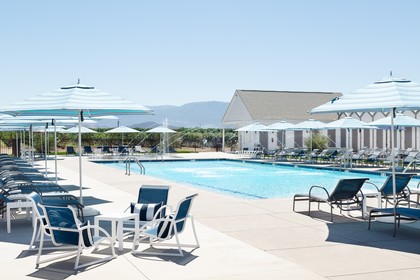
THE BARREL ROOM:
The “entry-level” tasting room was surrounded by barrels, real ones, aging real wine, not some fake place with leftover barrels that should be sawed in half and used for planters. This room would have limited capacity and every seat would be reservation-only. Servers would be able to move around the counters and show guests where the grapes are grown within our ranch, where the varieties originate in Italy, and what wines are made from them (In Italy not all wines are named after the variety, so this information is an important part of the story). Today the barrel room is one of our more popular choices and it most approximates the classic wine tasting venue in California without the crowds, the noise, and the drunks.
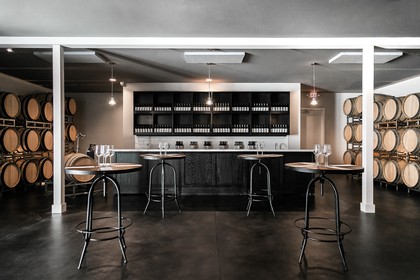
THE SEATED WINE PAIRING ROOM:
The next level of immersion was our “Seated Charcuterie” tasting. Much in vogue up in Napa but fairly rare down here, we thought that bar height tables in a communal setting with a choice of high-end charcuterie boards would be popular. It proved to be so, and it gave us the perfect venue to highlight these unusual and delicious wines as they are expected to be consumed, with food.
The wines featured were considered our “Reserves” and we offered three types of boards to accommodate the dietary needs of the modern attendee: Keto, vegetarian, and of course, the discerning omnivores. The host would be a major part of this experience explaining the wines, their history, and best food pairings. It has become our most popular experience.
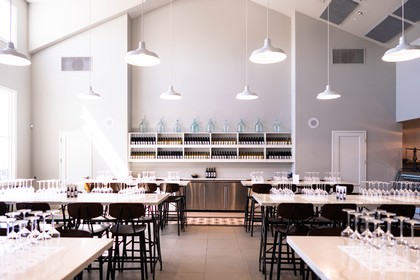
THE LAB:
The pièce de resistance would be the Wine Blending Lab complete with lab coats, pipettes, graduated cylinders, calculators, the works. For the true oenophile and the novice alike, this room was science and nature in one. Guests blending several wines from their aging barrels to blend into a truly personalized wine. The blend would be bottled and an “artsy" label would be designed and applied. The whole experience would be guided by a competent staff member.
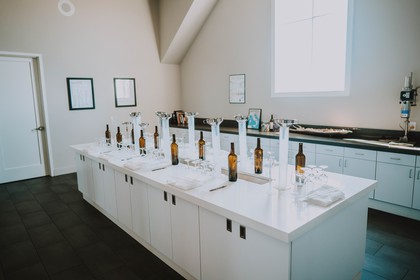
CONSTRUCTION:
The entitlement and construction were grueling. Conflicting regulations, changing staff at the county mid-project, and issues with consultants, turned the process into a three-year ordeal.
The lesson: Expect delays and cost overruns. California is not business-friendly. To save money, time and aggravation it is much better to build a winery in Oregon or Texas.
We started with grading and building a 6-foot-tall pedestal (Palladio’s technique). The County then delayed us for some reason so trivial no one remembers. During the delay, we deleted the planned restaurant, which cost us a year in permit modifications. When we finally poured the slab I looked around and thought: “This is a view – This doesn’t suck”.
The graders were digging the pool and seen from above it seemed immense. Almost too big. Sizes are deceiving during construction. When full and with the surrounding building it now looks about right.
The walls went up, and the roof was installed quickly. The white cladding took a few more days… As the buildings took shape folks thought it would be a church, and in fact some visitors have called the winery a “Cathedral of Wine”.
We installed fixtures and equipment, and then the interiors. The tile floors, case-goods, and painting took 2 months, after which we furnished the building. Truckloads of furniture and operating supplies were unloaded and placed. It’s a laborious process that requires a good eye and attention to detail.
We then loaded the OS&E (Operating Supplies and Equipment). From Deli stuff to kitchen supplies, to wine glasses, to coffee for the employee break room. The list was immense and so was the expense. It took several months to fine-tune what would actually be needed. No matter your previous experience you can never fully prepare for this. A new operation requires flexibility and patience.
Finally, after much anticipation, in late August of 2018, we welcomed our employees for training.
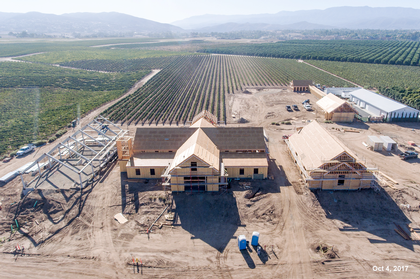
PERSONNEL - THE "SOFTWARE":
In any smooth working company, the most important element is the folks that make it all work. To manage the opening of Bottaia we selected one of the original Ponte employees. She had moved to Oregon to take over our newly acquired Hawks View Winery. Jayna Viereck had been with Ponte since she was 19 and had risen through the ranks thanks to her smarts and quick learning skills. After a year in Oregon, she had the requisite skill set to open the new winery. Under her, she had the recent UDSD graduate Juliet Ponte (my daughter) as a Supervisor. Nepotism? Of course! But she turned out to be pretty good.
We also hired managers for the Wine Club and the Pool + Bar, and about twenty servers and attendants, knowing that some would not make the grade. Some are still at the Bottaia as of this writing, but several have moved on. A three-day training program followed, teaching service standards, systems, wines, vineyards, rules, and regs, etc. It was a firehose of info, and many of the poor folks there had not been in a classroom setting for a while (some since middle schools it seemed), so it was tough for them (and for us). A couple of these brand new employees left that evening and never came back. Those that did had to be nimble as we adjusted to the guest expectations, post-construction hiccups (more on that next), and high standards.
With an existing company, the culture is baked in. You have someone leave and their replacement has no option but to fit in with the existing way of doing things, the work pace, and the way we treat the guests and each other. With a brand new team, it’s like coaching toddler soccer. The rules may be set, but not understood, and everyone has a different idea of how to play. The lesson for those who start a winery: Culture requirements must be very clear from the start, from the first interview and held high from then on.
It became evident over the next few weeks that we had underestimated the difficulty of teaching Italian varieties, wines, and our way of interpreting them to servers who at best had only a passing knowledge of California supermarket varieties. The best took up the challenge and studied on their own, using YouTube and books. Some of them are still with us here and have become truly knowledgeable. Just as difficult was to have servers provide high-end table service to a very varied clientele. In a few months we had it figured out but not without effort.
THE PUNCH LIST:
A punch list is a list of pending items after the building is turned over to the owner. Anything from patching holes, to installing speakers. Our General Contractor finished the punch list items (almost 100 items) quickly but it took almost a year to finish every item.
HOT TIP:
The time to build a new winery is when no one else is building. Prices are lower and the contractors and workers care about their jobs and getting paid on time. If you have the time, wait. It will save you lots of money. The best time to break ground is when all developers, builders, and investors are scared.
LESSONS LEARNED:
- Spend money and time on planning and research. For every dollar you spend early you will save $10 in mistakes later. Decide on the brand, the image, and the program early. Will you be experience-based or product-based? Who is your target audience? What happens when they (and you) are 10 years older?
- Hire a consultant who can guide you. If you want to build or buy a winery, decide how much you know, how much you don’t, and find someone who can teach you what you don’t know that you don’t know. This someone will hopefully not take all your money, but will not be cheap. This is not the place to save. Have a backup for every consultant. Make sure the contracts give you ownership of all the work product.
- In California, take your planner or government officials’ statements with a grain of salt. They will tell you “No problem,” but later everything will be a problem. Money and time will be required to solve them. Some issues are easy to resolve, some not so much. Money and time, that’s all it takes. You better have plenty of both, plus energy and patience.
- Building a winery is a unique project. There are no standards. We all understand how a hotel or a shopping center works. We have a good idea of layouts and adjacencies for most building types. Not so for wineries. They are unique, each in its own way. They must fit the site, the clientele, the image & brand, and the budget of the owner. Just because you’ve built stuff before don’t think you have a special advantage.
- If you think a professional is expensive wait until you use an amateur. Hire quality professionals for design, and construction. The lowest bidder will invariably disappoint you. That’s why it’s important to build when things are slow. You can choose a middle bidder, save, and still get a good product.
- For a visitor-focused winery, the “adjacencies” are incredibly important. How do guests get from the parking lot to their table? Where are the restrooms? Is there sufficient storage? (there’s never enough); how do the grapes get processed? Will service spaces be visible to guests? How do the servers move around, and how does the layout affect the experience? Get an expert to help you. Because once the walls are up, you are stuck with your error. Forever.
- Do something new. Copying others will not work. Doing something new may bring ridicule but if you are very lucky it could get you on the cover of Wine Spectator magazine.
- Start small and be impatient for profits. Grow sales later. If there are no profits within two years, change the game plan or risk going broke.
- Wine takes time to grow, make, age and bottle it. Match your wine program to the construction schedule. Better have too much red wine, and very little white wine. If you are delayed the reds should get better, the whites will not.
- Keep it simple. KISS.
- If a consultant, employee, or banker disappoints you, replace them quickly.
- Hire a good GM early and make sure he/she can sell.
- Test for leadership in your GM and supervisors. This can be learned and taught. But I find that it’s best if someone trained them beforehand. You are too busy establishing your brand to become a teacher, no matter your prior experience.
- Do not let your lawyer or your accountant run the business. They are "the brakes”. Cautious and conservative, they will cause problems, and then charge you to solve them.
- Keep staffing under control. If you can avoid going over 50 employees do so. The labor laws get worse at specific thresholds.
- Avoid restaurants. Instead, invest in digital marketing and sell more bottles online.
- Building and owning a winery is a business, not a game. Want to play? Learn to golf. Want to make new friends? Donate to a charity and get on their board.
Now it’s time for a glass of Montepulciano, and a dip in the pool.
Cheers, Claudio Ponte
Comments
Commenting has been turned off.Recent Posts
-
July 1, 2023
-
May 13, 2023
-
April 15, 2023
-
November 25, 2022
-
June 1, 2022
-
May 6, 2022
-
March 24, 2022
-
March 21, 2022
-
February 24, 2022
-
December 1, 2021
